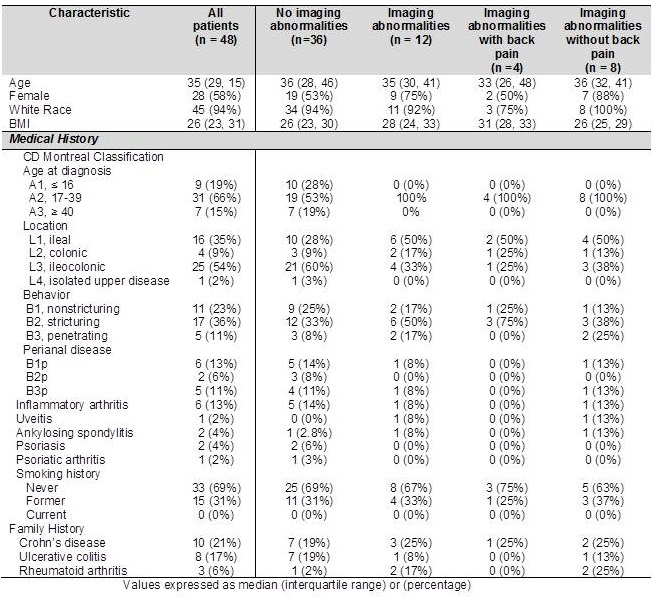Session Information
Date: Monday, November 8, 2021
Session Type: Poster Session C
Session Time: 8:30AM-10:30AM
Background/Purpose: Inflammatory bowel disease (IBD) affects up to 1.3% of the population and is associated with musculoskeletal manifestations including spondyloarthritis (SpA). Axial SpA (axSpA) is estimated to occur in 3-10% of IBD patients, but variation in imaging modalities and diagnostic criteria may underestimate the prevalence. Early recognition and identification of inflammatory changes on imaging can influence treatment that can alleviate symptoms, prevent radiographic progression, and improve quality of life. The aim of this study is to determine the prevalence of inflammatory changes on imaging in the Crohn’s disease (CD) population utilizing routine magnetic resonance enterography (MRE) or magnetic resonance imaging (MRI) and to identify patient characteristics that can assist in early recognition of axSpA.
Methods: This is a retrospective chart review of patients with a diagnosis of CD at our institution between 2014 and 2020. Inclusion criteria included patients with CD, 18 years of age or older, with MRE or MRI pelvis studies available for review. Exclusion criteria included patients with ulcerative colitis, less than 18 years of age, and those without imaging. Images were reviewed by a blinded radiologist using the Assessment of Spondyloarthritis international Society criteria including abnormal enhancement on T1- weighted fat-saturated images and bone marrow edema on T2-weighted fat-saturated images as well as inflammatory structural lesions such as fat deposits, erosions, sclerosis, or ankylosis. Demographics, medical history, medications, and labs at the time of imaging were recorded. Patients were assessed by a questionnaire for rheumatologic symptoms including inflammatory back pain and peripheral joint manifestations.
Results: 48 patients met the inclusion criteria. 41 had MREs and 7 had MRIs of the pelvis. 12 patients (25%) were identified with imaging abnormalities, all of which were found on MREs. 7 had structural lesions indicating prior inflammation and 5 were noted to have abnormal enhancement or bone marrow edema in the sacroiliac joints. From the 12 patients with imaging abnormalities, 8 (67%) were asymptomatic with no reported back pain or stiffness, 9 (75%) were female, 8 (67%) had stricturing or penetrating CD (Table). 3 patients (25%) were seeing a rheumatologist. From all the patients surveyed, 13 (30%) reported back pain, 26 (59%) reported previous joint pain or swelling, 13 (30%) had previous entire digit swelling, and 16 (36%) reported previous heel pain.
Conclusion: This study reveals that among Crohn’s disease patients at our institution, the prevalence of abnormal sacroiliac joint findings on MRE and MRI is 25%. Majority of these patients did not report back pain, were female, and had intestinal complications of CD. Only 25% were following with a rheumatologist. Asymptomatic or subclinical axSpA in Crohn’s disease patients remains under diagnosed and our study suggests that MREs should be routinely evaluated for musculoskeletal abnormalities. Furthermore, female sex and sticturing or penetrating CD may be risk factors for axSpA. Patients with these characteristics should be formally evaluated for the presence of inflammatory back pain as part of their clinical care.
 Table. Patient characteristics and medical history. BMI: Body mass index; CD: Crohn’s Disease; B1p: nonstricturing perianal disease; B2p: stricturing perianal disease; B3p: penetrating perianal disease
Table. Patient characteristics and medical history. BMI: Body mass index; CD: Crohn’s Disease; B1p: nonstricturing perianal disease; B2p: stricturing perianal disease; B3p: penetrating perianal disease
To cite this abstract in AMA style:
Quimson L, Oren N, Burns C, Jan R. Clinical and Imaging Characteristics of Spondyloarthritis Among Crohn’s Disease Patients [abstract]. Arthritis Rheumatol. 2021; 73 (suppl 9). https://acrabstracts.org/abstract/clinical-and-imaging-characteristics-of-spondyloarthritis-among-crohns-disease-patients/. Accessed .« Back to ACR Convergence 2021
ACR Meeting Abstracts - https://acrabstracts.org/abstract/clinical-and-imaging-characteristics-of-spondyloarthritis-among-crohns-disease-patients/
